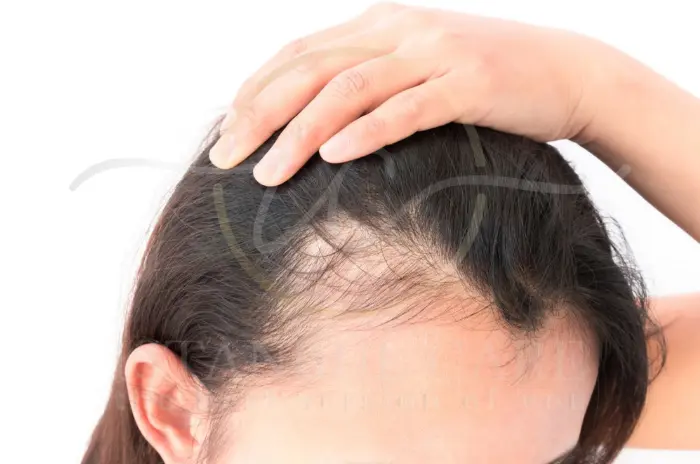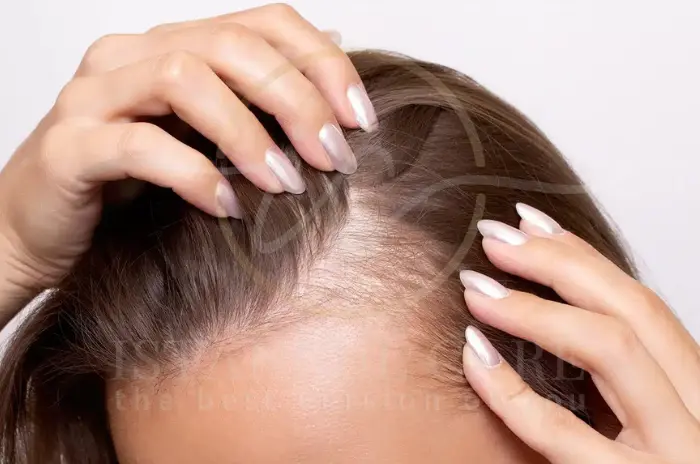Hair loss in women can be a distressing experience that affects self-confidence and overall well-being. While many factors contribute to hair thinning, hormonal imbalances are among the most significant causes of female hair loss. Understanding which hormones affect hair growth and how to address these imbalances is crucial for effective treatment and prevention.

What Is Hormonal Hair Loss in Women?
Hormonal hair loss in women refers to hair thinning or shedding that occurs due to fluctuations or imbalances in hormone levels. Unlike temporary hair loss from stress or nutritional deficiencies, hormonal hair loss often follows specific patterns and can be persistent without proper treatment.
Understanding the Link Between Hormones and Hair Growth
The relationship between hormones and hair growth is complex and interconnected. Hair follicles contain receptors that respond to various hormones circulating in the bloodstream. When hormone levels fluctuate, these receptors trigger changes in the hair growth cycle, potentially leading to:
- Shortened growth phases
- Prolonged resting phases
- Miniaturization of hair follicles
- Reduced hair shaft diameter
How Hormones Influence the Hair Cycle
The hair growth cycle consists of three main phases, each influenced by different hormones:
| Hair Cycle Phase | Duration | Hormonal Influence | Effect on Hair |
|---|---|---|---|
| Anagen (Growth) | 2-7 years | Estrogen, Thyroid hormones | Active hair growth |
| Catagen (Transition) | 2-3 weeks | Multiple hormones | Hair follicle shrinkage |
| Telogen (Resting) | 3 months | DHT, Cortisol | Hair shedding preparation |
Which Hormone Causes Hair Loss in Females?
Multiple hormones can contribute to hair loss in women, with each affecting the hair growth cycle differently. Understanding these hormonal culprits is essential for targeted treatment approaches.
DHT (Dihydrotestosterone) and Female Hair Loss
Dihydrotestosterone (DHT) is the primary hormone responsible for androgenetic alopecia, the most common form of hair loss in women. This potent androgen is created when the enzyme 5-alpha reductase converts testosterone into DHT. Key characteristics include:
- Genetic sensitivity: Some women inherit hair follicles that are genetically sensitive to DHT
- Progressive thinning: DHT causes gradual miniaturization of hair follicles
- Pattern baldness: Typically affects the crown and top of the scalp
- Irreversible changes: Without treatment, DHT-induced hair loss continues to progress
Thyroid Hormone Imbalance and Hair Thinning
Both hyperthyroidism and hypothyroidism can significantly impact hair growth:
Hypothyroidism (Underactive Thyroid):
- Slows down hair growth cycle
- Causes diffuse hair thinning
- Makes hair dry and brittle
- Often affects eyebrow hair as well
Hyperthyroidism (Overactive Thyroid):
- Accelerates hair growth cycle
- Leads to excessive hair shedding
- Makes hair fine and fragile
- Can cause patchy hair loss
Estrogen Drop and Hair Shedding in Menopause
Estrogen plays a crucial protective role in maintaining healthy hair growth. During menopause, declining estrogen levels result in:
- Shortened anagen phase: Hair spends less time growing
- Increased DHT sensitivity: Less estrogen means more DHT activity
- Reduced hair density: Overall thinning throughout the scalp
- Changes in hair texture: Hair becomes finer and more fragile
Prolactin Rise and Hair Loss
Elevated prolactin levels, often seen during breastfeeding or due to pituitary disorders, can cause:
- Diffuse hair thinning
- Telogen effluvium (excessive shedding)
- Delayed hair regrowth
- Hormonal imbalances affecting other systems
Cortisol from Stress Leading to Hair Fall
Chronic stress elevates cortisol levels, which impacts hair growth through:
- Telogen effluvium: Pushing more hairs into the resting phase
- Nutrient diversion: Redirecting resources away from hair follicles
- Inflammation: Creating scalp conditions unfavorable for hair growth
- Hormonal disruption: Interfering with other hair-supporting hormones
Insulin Resistance and Hormonal Hair Loss
Insulin resistance affects hair growth by:
- Increasing androgen production
- Elevating cortisol levels
- Creating inflammation
- Disrupting nutrient absorption
How Do These Hormones Impact Hair Growth?
Understanding the specific mechanisms by which hormones affect hair growth helps explain why targeted treatments are necessary for different types of hormonal hair loss.
DHT Shrinks Scalp Hair Follicles
DHT binds to androgen receptors in hair follicles, causing a process called miniaturization. This process involves:
- Progressive shrinkage: Hair follicles become smaller with each growth cycle
- Shortened growth phase: Hair spends less time in the active growing phase
- Weakened hair shaft: New hairs grow thinner and more fragile
- Eventually dormant follicles: Severely miniaturized follicles stop producing hair
Thyroid Hormones Regulate Hair Cycle
Thyroid hormones T3 and T4 directly influence hair follicle function:
- Cellular metabolism: Control the energy production in hair follicle cells
- Growth phase duration: Regulate how long hair remains in the anagen phase
- Hair shaft formation: Influence keratin production and hair strength
- Follicle regeneration: Affect the follicle’s ability to produce new hair cycles
Estrogen Keeps Hair in Growth Phase
Estrogen supports hair growth through multiple mechanisms:
- Prolongs anagen phase: Keeps hair growing for longer periods
- Improves circulation: Enhances blood flow to hair follicles
- Blocks DHT: Reduces the negative effects of androgens
- Supports keratin production: Maintains hair strength and thickness
Prolactin’s Effect on Hair Follicles
Elevated prolactin affects hair growth by:
- Interfering with normal hormone cycles
- Reducing estrogen production
- Causing premature entry into telogen phase
- Creating hormonal imbalances that affect overall hair health
Cortisol Shortens Hair Growth Time
Chronic cortisol elevation impacts hair through:
- Premature telogen entry: Forces hair into resting phase early
- Reduced protein synthesis: Limits keratin production for hair strength
- Impaired nutrient uptake: Decreases absorption of hair-supporting nutrients
- Inflammatory responses: Creates scalp conditions that inhibit growth
Insulin Imbalance and Elevated Cortisol
Insulin resistance creates a cascade of hormonal effects:
| Insulin Effect | Resulting Hormone Change | Hair Growth Impact |
|---|---|---|
| Increased insulin | Higher androgen production | DHT-related hair loss |
| Insulin spikes | Elevated cortisol | Stress-related shedding |
| Poor glucose control | Reduced nutrient delivery | Weakened hair follicles |
| Chronic inflammation | Multiple hormone disruption | Overall hair thinning |
Common Hormonal Causes of Hair Loss in Women
Several specific conditions frequently cause hormonal hair loss in women, each with distinct characteristics and treatment approaches.
PCOS and Hair Thinning: The Hormonal Link
Polycystic Ovary Syndrome (PCOS) is a leading cause of hormonal hair loss in women of reproductive age. The condition involves:
Hormonal Imbalances in PCOS:
- Elevated androgens (testosterone, DHEA-S)
- Insulin resistance
- Irregular or absent ovulation
- Reduced estrogen production
Hair Loss Patterns in PCOS:
- Male-pattern baldness (androgenetic alopecia)
- Thinning at the crown and temples
- Increased facial and body hair (hirsutism)
- Progressive hair loss without treatment
Postpartum Hair Loss: Why Hormones Play a Role
Pregnancy and childbirth create dramatic hormonal fluctuations that significantly impact hair growth:
During Pregnancy:
- High estrogen levels keep hair in growth phase
- Many women experience thicker, fuller hair
- Normal hair shedding is reduced
After Delivery:
- Rapid estrogen decline triggers telogen effluvium
- Hair that should have shed during pregnancy falls out
- Peak shedding occurs 3-6 months postpartum
- Normal hair growth typically resumes within 12 months
Menopause and Hair Loss: Declining Estrogen Levels
Menopause represents a major hormonal transition that frequently leads to hair changes:
Perimenopausal Changes:
- Fluctuating estrogen and progesterone levels
- Irregular menstrual cycles
- Beginning of hair thinning in some women
Postmenopausal Hair Loss:
- Significantly reduced estrogen production
- Relative increase in androgen activity
- Progressive hair thinning, especially at the crown
- Changes in hair texture and growth rate
 How to Recognize the Symptoms of Hair Loss
How to Recognize the Symptoms of Hair Loss
Early recognition of hair loss symptoms allows for more effective intervention and better treatment outcomes.
Signs of Female Pattern Baldness
Female pattern baldness typically presents differently than male pattern baldness:
Early Signs:
- Widening part line
- Thinning at the crown
- Reduced hair volume
- Increased hair on pillow or in shower drain
Progressive Symptoms:
- Visible scalp through thinning areas
- Shortened hair growth phase
- Miniaturized hair follicles producing fine, short hairs
- Overall reduction in hair density
When to See a Healthcare Provider
Seek professional evaluation if you experience:
- Sudden or rapid hair loss
- Hair loss accompanied by other symptoms (fatigue, weight changes, irregular periods)
- Hair loss that doesn’t improve within 6 months
- Patchy or unusual patterns of hair loss
- Family history of hormonal disorders
Understanding Female Pattern Hair Loss
Female pattern hair loss is the most common type of hair loss in women, affecting up to 50% of women over age 50.
What Is Androgenetic Alopecia in Women?
Androgenetic alopecia in women is characterized by:
- Genetic predisposition: Inherited sensitivity to DHT
- Hormonal influence: Triggered or worsened by hormonal changes
- Progressive nature: Gradually worsens without treatment
- Diffuse thinning: Unlike men, women typically maintain their hairline
Genetic and Hormonal Factors in Hair Loss
The development of female pattern hair loss involves both genetic and hormonal components:
Genetic Factors:
- Inherited from either parent
- Multiple genes involved
- Determines follicle sensitivity to hormones
- Influences age of onset and severity
Hormonal Triggers:
- Menopause and declining estrogen
- PCOS and elevated androgens
- Thyroid disorders
- Stress and cortisol elevation
Signs and Stages of Female Hair Thinning
Female pattern hair loss follows a characteristic progression:
| Stage | Description | Visible Changes |
|---|---|---|
| Stage I | Minimal thinning | Slightly wider part, subtle volume loss |
| Stage II | Moderate thinning | Noticeable crown thinning, wider part |
| Stage III | Advanced thinning | Significant crown hair loss, visible scalp |
Treating Hormonal Hair Loss in Women
Effective treatment of hormonal hair loss requires addressing the underlying hormonal imbalances while supporting hair regrowth.
Hormone Replacement Therapy and Other Treatments
Treatment options vary depending on the specific hormonal cause:
For Menopausal Hair Loss:
- Hormone replacement therapy (HRT)
- Topical estrogen treatments
- Anti-androgen medications
- Minoxidil for hair regrowth
For PCOS-Related Hair Loss:
- Birth control pills to regulate hormones
- Anti-androgen medications (spironolactone)
- Metformin for insulin resistance
- Lifestyle modifications
For Thyroid-Related Hair Loss:
- Thyroid hormone replacement (levothyroxine)
- Regular monitoring and dose adjustments
- Nutritional support
- Patience for hair regrowth (3-6 months)
Lifestyle Tips to Support Healthy Hair Growth
Supporting hormonal balance through lifestyle changes can significantly improve hair health:
Nutritional Support:
- Adequate protein intake (1.2-1.6g per kg body weight)
- Iron-rich foods and supplements if deficient
- Omega-3 fatty acids for inflammation reduction
- B-vitamins, especially biotin and folate
Stress Management:
- Regular exercise to reduce cortisol
- Meditation and mindfulness practices
- Adequate sleep (7-9 hours nightly)
- Professional counseling if needed
Hair Care Practices:
- Gentle handling of wet hair
- Avoiding tight hairstyles
- Using sulfate-free shampoos
- Protecting hair from heat damage
When to Consult a Hair Loss Specialist
Consider specialist consultation when:
- Multiple treatment attempts have failed
- Hair loss is rapidly progressing
- Unusual patterns of hair loss are present
- Underlying medical conditions need specialized care
An intermediary organization can help connect you with appropriate specialists, including dermatologists, endocrinologists, and trichologists.
Preventing and Managing Hair Loss in Women
Prevention and early intervention are key to managing hormonal hair loss effectively.
Lifestyle Changes to Support Hair Health
Implementing supportive lifestyle changes can help prevent and slow hormonal hair loss:
Diet and Nutrition:
- Protein adequacy: Ensure sufficient protein intake for keratin production
- Micronutrient optimization: Focus on iron, zinc, vitamin D, and B-vitamins
- Anti-inflammatory foods: Include omega-3 rich fish, leafy greens, and berries
- Limit processed foods: Reduce insulin spikes that can worsen hormonal imbalances
Exercise and Activity:
- Regular moderate exercise to balance hormones
- Strength training to support metabolism
- Yoga or tai chi for stress reduction
- Avoid excessive high-intensity exercise that can increase cortisol
When to See a Doctor About Hair Loss
Prompt medical evaluation is important when hair loss:
- Occurs suddenly or in patches
- Is accompanied by scalp irritation or inflammation
- Happens alongside other concerning symptoms
- Doesn’t improve with basic interventions within 3-6 months
Hair Care Tips for Thinning Hair
Proper hair care can help maximize the appearance and health of thinning hair:
Gentle Handling:
- Use wide-tooth combs on wet hair
- Pat hair dry instead of rubbing
- Avoid excessive brushing
- Sleep on silk or satin pillowcases
Styling Strategies:
- Choose volumizing products
- Consider shorter hairstyles
- Use root-lifting techniques
- Avoid heavy oils or serums
Stress Hormones and Hair Growth
The relationship between stress and hair loss is well-established, with cortisol playing a central role in stress-induced hair loss.
How Cortisol Contributes to Female Hair Loss
Cortisol affects hair growth through multiple pathways:
Direct Effects:
- Binds to hair follicle receptors
- Shortens the anagen (growth) phase
- Increases hair follicle sensitivity to DHT
- Impairs keratin synthesis
Indirect Effects:
- Disrupts other hormone production
- Increases inflammation
- Affects nutrient absorption
- Disturbs sleep patterns crucial for hair growth
The Link Between Chronic Stress and Thinning Hair
Chronic stress creates a vicious cycle that perpetuates hair loss:
- Initial stressor triggers cortisol release
- Elevated cortisol affects hair growth cycle
- Hair loss creates additional psychological stress
- Increased stress leads to more cortisol production
- Cycle continues without intervention
When Should You Seek Help for Hormonal Hair Loss?
Early intervention is crucial for successful treatment of hormonal hair loss. Recognizing when to seek professional help can make a significant difference in treatment outcomes.
Signs of Hormone-Related Hair Thinning
Key indicators that suggest hormonal causes include:
Physical Signs:
- Gradual thinning rather than sudden hair loss
- Pattern of loss (crown, temples, or diffuse)
- Changes in hair texture or growth rate
- Accompanying symptoms (irregular periods, weight changes, fatigue)
Timing Factors:
- Hair loss coinciding with hormonal life events
- Seasonal patterns of hair loss
- Response to hormonal medications
- Family history of similar patterns
Blood Tests and Hormone Checks
Comprehensive hormone testing typically includes:
| Hormone Test | Purpose | Normal Ranges (Women) |
|---|---|---|
| TSH, T3, T4 | Thyroid function | TSH: 0.4-4.0 mIU/L |
| DHEA-S | Adrenal androgens | 45-345 μg/dL |
| Total/Free Testosterone | Androgen levels | Total: 15-70 ng/dL |
| Estradiol | Estrogen status | Varies by cycle phase |
| Prolactin | Pituitary function | 4-23 ng/mL |
| Cortisol | Stress hormone | 6-23 μg/dL (morning) |
| Insulin/Glucose | Metabolic function | Fasting glucose <100 mg/dL |
Early Diagnosis for Better Treatment
Early diagnosis offers several advantages:
- More treatment options: Earlier intervention provides more therapeutic choices
- Better outcomes: Hair follicles respond better when damage is minimal
- Prevention of progression: Early treatment can prevent further hair loss
- Improved quality of life: Addressing hair loss early reduces psychological impact
Working with an intermediary organization can help streamline the diagnostic process and ensure comprehensive evaluation by appropriate specialists.
Speak with our expert Hair Transplantation specialists

Speak with our expert Hair Transplantation specialists
We’re ready to answer your questions
Frequently Asked Questions
Mounjaro does not directly cause hair loss as a pharmacological effect. However, the rapid weight loss commonly experienced with this medication can trigger telogen effluvium, a temporary form of hair thinning. The hair loss is typically related to the speed and extent of weight loss rather than the medication itself.
Key hormones include DHT which is the primary cause of pattern baldness, estrogen with low levels during menopause, thyroid hormones where both high and low levels affect hair, cortisol as a stress hormone causing hair shedding, insulin where resistance increases androgen production, and prolactin with elevated levels causing thinning.
Yes, PCOS is a leading cause of hair loss in reproductive-age women due to elevated androgens that convert to DHT, causing male-pattern baldness affecting the crown and temples.
Yes, declining estrogen and progesterone during menopause lead to shortened growth phases, increased DHT sensitivity, and overall thinning, especially at the crown.
Diagnosis involves medical history, physical examination, hormone blood tests, and sometimes specialized scalp examination. An intermediary organization can coordinate comprehensive testing.
Options include topical minoxidil, anti-androgen medications, hormone therapy, thyroid treatment, lifestyle changes, professional procedures like PRP, and nutritional supplements.
This temporary condition typically resolves within 12 months. Use gentle hair care, ensure adequate nutrition, manage stress, and consult professionals if loss persists beyond one year.
Yes, chronic stress elevates cortisol, causing telogen effluvium (diffuse shedding), worsening genetic hair loss, or triggering patchy hair loss. Stress management is crucial for prevention and treatment.

